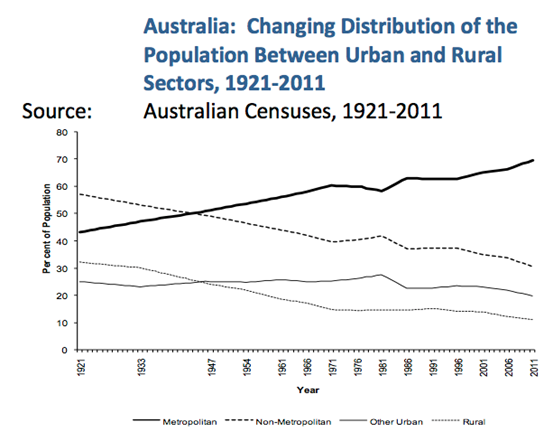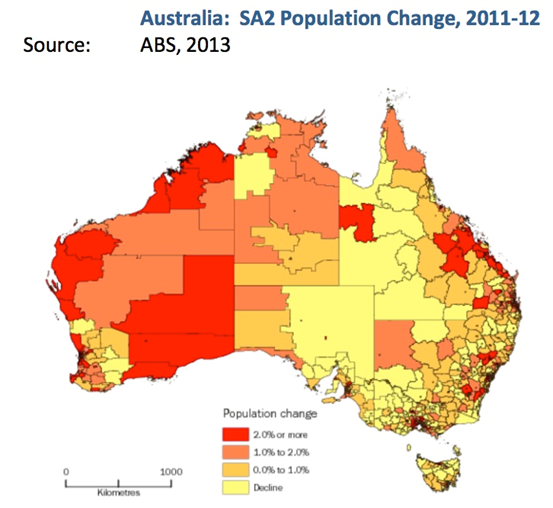Ripping off Australia above the dotted line
Scientists have, for centuries, repeated the maxim ‘nature abhors a vacuum’. However it is only in the past century or so that Australian politicians have been stuck on a similar maxim -- ‘voters abhors empty spaces on a map’.
And the Abbott government believes this more than most.
The new ‘Pivot North’ report released by the Joint Select Committee on Northern Australia shows how our largest, emptiest spaces on the map can be filled in with towns, industries, people and infrastructure to give us less to ‘abhor’.
It is a perennially beguiling objective -- to populate and develop those vast tracts of emptiness north of the Tropic of Capricorn.
So beguiling, in fact, that when the Coalition’s ‘2030 Vision for developing Northern Australia’ was leaked to Sydney’s Daily Telegraph newspaper in February 2013, this columnist wrote:
“... the Coalition appears to have been working hard on an impressive example of 'joined-up thinking' that promises to put Australia on a more even footing with our near neighbours -- by populating largely empty regions, producing more food for the growing global population, and offering economic salvation to hundreds of thousands of eager migrants”.
I was wrong. It didn’t take too long to realise the Coalition had not done its homework.
Its ‘foodbowl of Asia’ slogan, for example, was a feel-gool phrase that lacked any substance, as agriculture minister Barnaby Joyce recently admitted. (Barnaby’s boom needs Chinese wisdom, August 13 http://www.businessspectator.com.au/article/2014/8/13/politics/barnabys-boom-needs-chinese-wisdom) The soils of northern Australia are ancient, and very poor when compared to the fertile volcanic soils of Indonesia just to the north.
Let me state for the record that any solutions, economic or otherwise, that improve living conditions and health, education and social outcomes for indigenous people in the Top End are to be welcomed, and it’s true that many of the suggestions in the Pivot North report might help achieve those objectives.
That said, this is not a report aimed mostly, or even substantially, at helping indigenous communities. It is report designed to fill empty spaces on a map.
Had the government’s promise before the election been to develop all regional towns in Australia beginning with ‘P’, a similar report could have been written.
That’s because a survey of such towns would turn up opportunities in agriculture, tourism, defence, education and research, and so on, and social engineers in Canberra could get to work allocating funds to help develop them.
That, in a nutshell, is what’s wrong with the 2030 Vision. It aims to facilitate a host of development projects based on one unifying theme -- their ‘northness’.
Such an objective is cart-before-horse thinking.
If the objective is to coax Australians out of increasingly dysfunctional capital cities, a regional development plan, such as the $10 billion plan rolled out by Simon Crean from the early days of the Gillard government (Why Gillard put Crean first, September 2010), makes more sense.
That plan was supposed to recognise economic opportunities across Australia and make strategic infrastructure, education and technology investments to unlock them.
Put another way, Crean was supposed to ask “where in Australia are the best non-metropolitan opportunities?”
The Abbott government plan, by contrast, asks “where above the Tropic of Capricorn are the best opportunities”.
That is very poor economic reasoning.
Investment should flow to regions that produce the best returns -- and should only include public investment if one accepts the objective of redistributing Australia’s population away from the clogged roads and over-priced housing of our capital cities.
Historically, there has been a fairly gradual drift from regional centres to the big cities, as a policy briefing paper from Adelaide University’s Australian Population and Migration Research Centre shows.
The report states that whereas a rural-urban migration in countries like the US was fairly rapid, Australia’s internal migration has been more smooth (see chart below).

The same report also charts where population growth has recently been fastest. Unsurprisingly, it correlates strongly with mining industry areas (see map below) -- though the authors warn that the areas of ‘high growth’ (the red areas) have very low populations to start with, meaning that a 2 per cent growth rate could literally be just a few hundred mine workers.

What the map drives home, however, is the point made above. Isn’t it a bit arbitrary for a national policy to aim to make the parts of the map above the Tropic of Capricorn ‘red’?
Aside from improving the lot of indigenous peoples -- and there is no guarantee the plan would -- the other main argument is for reasons of strategic defence.
Various towns up north made submissions to the joint committee’s inquiry, to argue that they were the ideal places to host warships or other military bases.
Cairns Regional Council said, for instance, “We do not want all our Defence people sitting in the southern part of Australia ready to reinvent the Brisbane Line. We want them up in the north here where most of their work is, both in terms of strategic military importance and also aid to countries north of us when they have natural disasters.”
Good point, though the Department of Defence doesn’t see it the same way. It argued that it was unwise to “put all your assets in one place and then find the operation is in another area of Northern Australia”. Another good point. Cairns is a lot closer to Sydney than to Exmouth.
The DoD said its strategy for defending the north relied on “increasing its presence in the North rather than increasing its bases”.
Even if one accepts most of the arguments about economic opportunities in the north just waiting to be tapped, history has taught us that southerners are still every reluctant to move into the tropics.
Special economic zones are one suggestion to fix this. However, SEZs overseas typically use preferential tax rates to tempt companies and individuals to them.
In Australia, there are constitutional problems with doing this as “federal taxation cannot discriminate between states (or within states) and preference cannot be given to one state (or part of a state) over another in laws or regulations of trade, commerce or revenue”.
So to get around this, the idea has been floated of forgiving graduates their HECs debt if they move for a period of time to the north.
The difficulty will be in explaining to other regional areas in southern Australia, also desperately in need of graduates, why a project in the NT is worth more than one in South Australia.
Voters may abhor empty spaces, though for the time being they seem to accept them when they are between the ears of politicians.
















